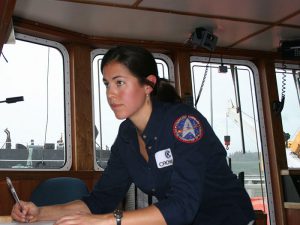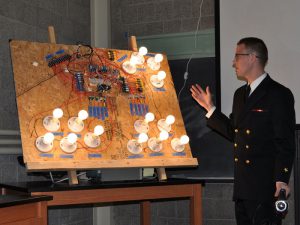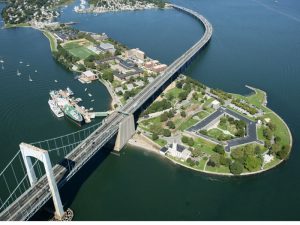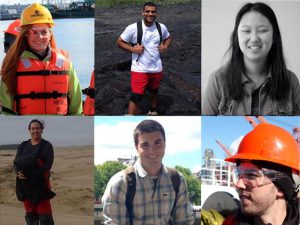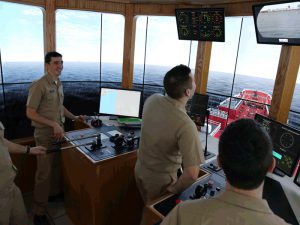
The Course to Career Success
An increasingly technical world – on board and ashore – and a growing mariner shortage have conspired to make maritime education and training more important than ever. The maritime world plays a significant role in moving the global economy and its goods, people and power. Educational institutions ensure those responsible for moving the world’s assets across the seven seas are well-qualified and prepared for their roles.
According to the latest BIMCO and ICS manpower report, the industry is facing a need for nearly 150,000 officers in the next decade and is already short 16,000 officers. The need to keep men and women sailing on their licenses for longer, and to recruit and train new officers, is growing steadily. In times of high demand, it is not unknown for the quality of a product to decrease. Yet that is an unconscionable risk for the maritime industry and its regulatory agencies. In fact, requirements to earn and upgrade a license are becoming more stringent, meaning that maritime educators must take additional steps to ensure the necessary requirements are met for all entering the fleet.
Additionally, vessels and operating procedures are becoming increasingly complicated; it is imperative that the men and women in charge of them and their cargo know what they are doing.
At SUNY Maritime College in New York City, the professional education and training department is responsible for giving professional mariners the continuing education they need to stay current and qualified under changing regulations. The program also trains students for limited tonnage licenses, playing an important role in the nation’s brownwater fleet.
For more than 100 years, SUNY Maritime has educated and trained merchant mariners, changing its curriculum, facilities and program offerings to align with the needs of the industry and U.S. Coast Guard requirements. Once again, the college is working to meet the growing mariner demand and to ensure that they succeed in their pursuit of Coast Guard mariner credentials.
The changes – among others – include offering additional courses to help licensed mariners maintain and update their skills as well as building facilities to train new mariners. The Manila amendments to the International Convention on Training, Certification and Watchkeeping standards, approved in 2010, go into effect at the end of the year. Safety is, and always will be, paramount to the maritime landscape, and the Manila amendments are designed to enhance crew safety at sea.
The amendments require, among other things, that all mariners take regular courses in basic training, renew their endorsements, and pass leadership courses to upgrade and maintain their credential.
No longer is experience at sea enough.
Basic training, which covers all the subjects most important to a vessel’s safety, still teaches basic firefighting, personal survival techniques, personal safety and social responsibility, and basic first aid. But now mariners will need to take the course, or a version of it, every five years in their professional careers.
After the end of the year, mariners entering the profession will take the original 40-hour course that has been taught for years and which introduces them to onboard safety operations. A 16-hour refresher course will be required for all who have not accrued 360 days of sea time in the past five years. An 8-hour course has been designed for mariners who have accrued the 360 days in a five-year period.
Nor is it enough anymore to earn lifeboatman, fast rescue boat or tankerman-PIC endorsements once and carry them for life. Once the Manila amendments go into effect, mariners must renew these qualifications to keep them.
These courses are being developed by a variety of players, including state maritime academies like SUNY Maritime.
Industry professionals, executives and thought-leaders have always prized safety over all else—safety of their crews, their vessels and, lastly, of their cargo. But tragedies like the sinking of the El Faro serve as an unfortunate reminder to all of us of how dangerous our industry can be and how necessary these skills are for the well-being of all who sail.
Safety practices and awareness are, of course, the most important thing that maritime educators impart to their students. This is a dangerous field and there are too many things that can go wrong.
But the Manila amendments have also recognized the increasing importance of a second set of skills related to teamwork and leadership, not only for those in leadership positions but for all officers onboard a vessel.
The essence of Coast Guard licensure training, at SUNY Maritime and elsewhere, is focused on developing mates and engineers who can work together and make decisions. The Coast Guard requires a regimented lifestyle and, though interpretations of that lifestyle vary, the focus is in developing an individual’s character and leadership skills so that the safety of the crew and vessel are paramount, rather than individual wants and needs.
But the regimental program at SUNY Maritime, in keeping with STCW standards, now includes leadership and teamworking training, while professional mariners can come to the campus to take the individual course. The course will focus on case studies, workload management, maritime conventions and regulations, and situational awareness to enhance decision making skills.
STCW standards also include training for those looking to advance into personnel management positions on both the deck and engine sides of vessel operations. More training has been added to ensure that officers can work together to, once again, ensure the vessel’s operations go as smoothly and safely as possible. The 35-hour course is required for all chief mates, masters, second engineers and chief engineers. It focuses on managing and training shipboard personnel, building situational awareness, and optimizing the use of engineering and bridge resources, among other things.
These requirements are the latest expansion of the necessary training for licensed mariners.
As the scope of training expands, so too have the resources and facilities at the academies which have grown and become more sophisticated. Ships and other vessels are increasingly technical and, though training ships and cadet commercial shipping assignments offer real-world experience onboard, it is unwise to allow a future mariner to sail without previous knowledge and virtual experience.
Simulation technology has become so advanced that cadets and mariners can gain experience with nearly any situation before ever stepping onboard. In a simulator, future mariners can practice standing watch anywhere in the world on a vessel powered by any form of fuel. As the global fleet changes from steam to diesel to, increasingly, natural gas in an effort to reduce pollution, these opportunities help professional mariners gain the experience they need to sail for a variety of companies and on a variety of vessels.
All of the maritime academies have expanded their simulation centers and systems in recent years. At SUNY Maritime, in the past year programs have built or expanded a tug and barge simulator and a full mission engine room simulator, which is enhanced with a 20 desktop station classroom to allow as many students to gain experience as possible.
These technologies, as complex as they are, can only produce data from which a student can learn. The equipment allows for—indeed it requires—a large amount of human interaction.
After all, the human element is by far the most important element of any vessel at any time and in any place. Interpreting the data onboard a simulator allows a professional mariner to correctly interpret the data coming from a vessel’s systems and act based on that data to ensure the safety of the vessel, cargo and crew.
Simulators and simulation systems are imperative for cadets and mariners to become familiar with the equipment onboard a vessel and that they will someday use and be responsible for. Simulation allows them to learn, within a controlled environment, what a navigational bridge or engine room is capable of and how to harness it to move a vessel safely from one port to another. Such training exercises allow students to make mistakes and learn from them without risking millions of dollars, environmental damage and lives.
Simulators at SUNY Maritime, as at the other academies, are nothing new. SUNY Maritime has several Class A bridge simulators, radar/ARPA ECDIS labs and a liquid-cargo handling simulator. As onboard technology and simulation programs become increasingly sophisticated, maintenance and software upgrades ensure that future mariners are getting the best experience possible and that which most closely mimics the world they will be sailing in after earning their Coast Guard licenses.
Partnerships with maritime companies help to ensure not only that new mariners are getting the appropriate training, but that current mariners can also return to maintain and upgrade their credentials. The ATB simulator at Maritime College has been supported and expanded through the generosity of Bouchard Transportation Company, Inc. The latest expansion includes two Class B stations to allow coordination between up to three tugs and a barge.
Mariners and cadets working in SUNY Maritime’s engine room simulator have the additional benefit of being able to train remotely through cloud technology. The simulator is no longer bound to the room in which it is confined, and trainees are able to spend additional time with the equipment. This capability, combined with digital textbooks, means that the possibilities for training and continuing education are endless.
These simulators and additional STCW courses help our nation’s mariners adapt to and thrive in an ever-changing industry. The same way that any other professional must adapt to the changes brought on by the information revolution and a changing world, so too must the mariner. Indeed, since the mariner travels the world and plays such a large role in the functioning of the global economy, the needs for continuing education and training are perhaps even more important than most other professions.
